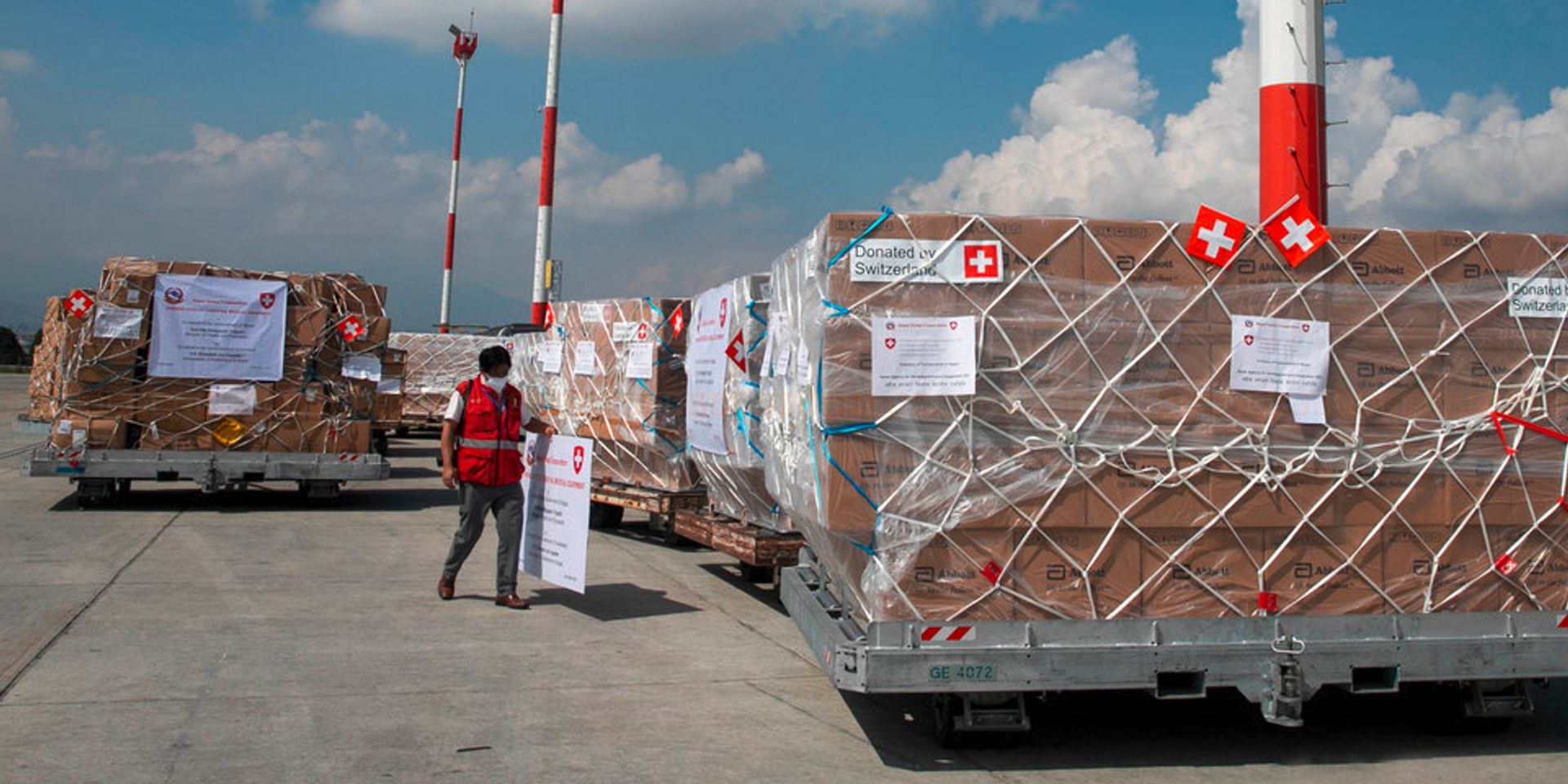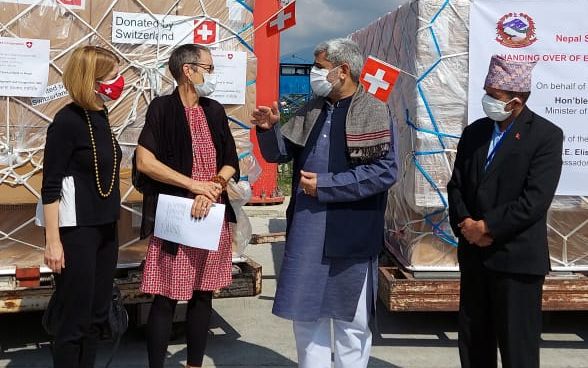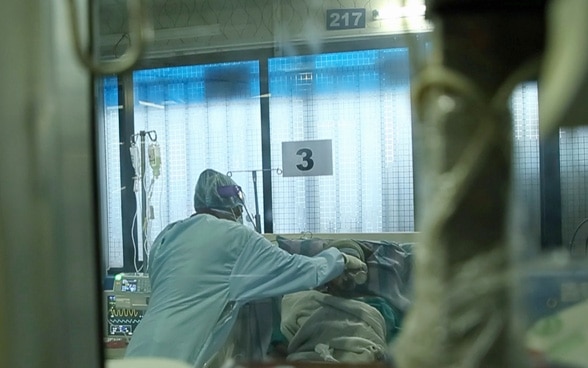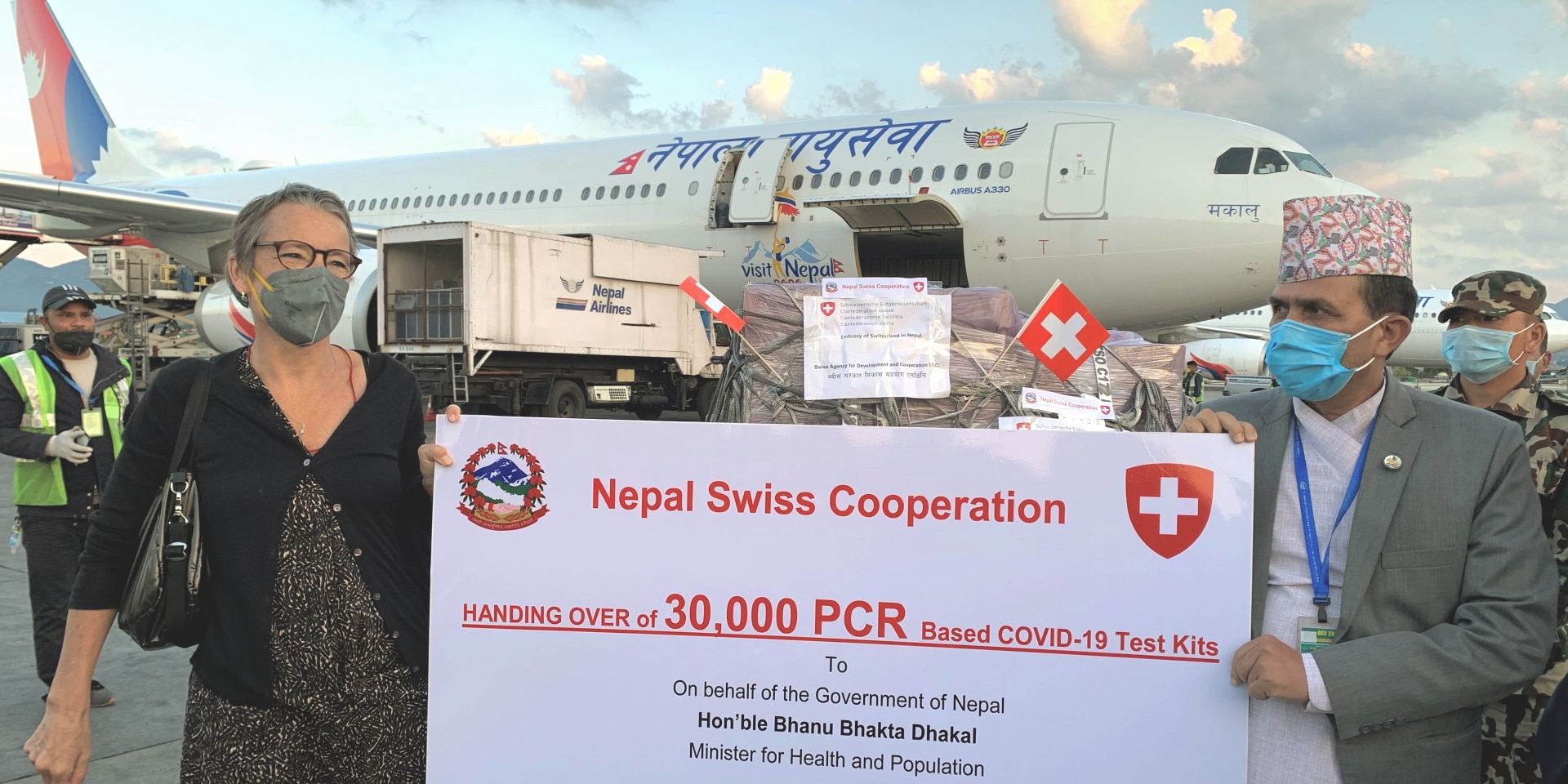"It's important for development cooperation to be able to react quickly to crisis situations"
In late May, thirty tonnes of relief supplies were sent from Switzerland to Nepal to help the country in its battle against COVID-19. According to Elisabeth von Capeller, the Swiss ambassador to Nepal, the delivery illustrates how to effectively combine development cooperation and emergency aid: Switzerland can react quickly to Nepal's requests for help while using its long-standing development cooperation partnership with the country to open up access and strengthen systems on the ground.

After landing in Kathmandu: Switzerland's aid delivery is brought to a warehouse, where it will then be transported to the places that need it most. © Prabin Ranabhat / Pahilopost.com
Ms von Capeller, Switzerland sent 30 tonnes of relief supplies to Nepal at the end of last week. Where are these supplies needed?
There's enormous unmet need in Nepal, and the healthcare system is completely overwhelmed. There are very few doctors and intensive care beds in the country, which can't do much to hold back the pandemic.

What kinds of supplies did Switzerland prioritise for this shipment?
We concentrated on supplies that we could provide immediately and that could be used to bolster the healthcare system. Switzerland was not in a position to grant every request. We couldn't supply any vaccines, for example, even though they are urgently needed.
That's why we sent around 1.1 million antigen tests; Nepal has a PCR testing capacity of only 20,000 tests per day. The tests are mostly carried out in Kathmandu and provincial capitals. Now with the antigen tests sent by Switzerland, Nepal will be able to quickly and easily conduct tests in villages and at border crossings. The Swiss tests have already arrived in the provinces and been sent out to the municipalities from there.
Switzerland also sent 40 ventilators in addition to the tests.
Yes. Here the situation is a little different. Ventilators are highly specialised devices. They can only be used in hospitals that already have intensive care units and trained staff. But they're still urgently needed: in Nepal there are just 600 ventilators for a population of almost 30 million people. The Ministry of Health told us which hospitals would be receiving our ventilators, and we're working with Hamilton's local distributor to get them installed.

What role did the embassy play in preparing the aid shipment? What organisations did the embassy work with to make it happen?
Prior to the shipment, the embassy was in close contact with different Nepalese government agencies along with other donors. We coordinated with the Ministry of Health, the Nepalese crisis unit, the UN, the World Bank and other partners in order to ensure that urgently needed goods could be delivered to Nepal quickly and without duplicating any efforts. We also got the necessary landing and import permits from the relevant authorities. Coordinating this effort in the middle of a health crisis was a great challenge for the embassy.
Several months ago, Switzerland supported Nepal by helping to deliver COVID-19 test kits. How has the situation developed since then? What's your impression of conditions in the country?
There are now many more people impacted compared to the first wave last year. Younger people are also experiencing more severe symptoms. The government has issued strict pandemic measures, and people are scared. Kathmandu is currently like a ghost town. But this situation is not tenable; there's no social insurance system in Nepal, and people have to work in order to survive. The social and economic consequences of the pandemic have hit the country hard. Hundreds of thousands of people are at risk of falling back into poverty. And all of this is coming at a time when Nepal is still recovering from the severe earthquake of 2015. On top of the pandemic, the country is also in the midst of a serious political crisis. Fresh elections are supposed to be held this year following the dissolution of parliament.
For its international cooperation work in Nepal, Switzerland has adopted a systemic approach that aims for long-term impact. In concrete terms, how can Switzerland help Nepal fight the pandemic, which is of course not just a health emergency, but also a social and economic crisis?
It's important for development cooperation to be able to react quickly and flexibly to crisis situations. Last year we extensively adapted our programmes to the new situation. For instance, a project that normally focused on preparing migrants for leaving the country changed its focus in the short-term to migrants who were coming back.
Switzerland was able to respond to the Nepalese government's urgent requests with some targeted interventions, for example by helping the country acquire 70,000 PCR kits. They arrived in Nepal just as the country was running out of tests. These kinds of actions build trust in Switzerland and strengthen our reputation as a reliable partner.
The SDC also helped hospitals expand their water and waste management systems and set up a fund for micro-enterprises and small businesses so that they could keep working and providing their employees with work during the crisis. Even during a crisis, it's important to stick to a systemic approach where we are building up and supporting systems that will have a long-lasting impact.
The latest relief delivery is an emergency aid measure. Using this example, can you explain Switzerland's approach of combining short-term emergency aid with long-term development support in the same country?
It's important for Switzerland to act flexibly with the tools it has available, with development cooperation and emergency humanitarian aid complementing one another. Emergency humanitarian aid was provided quickly in response to Nepal's request for help, while Swiss development officials were able to use their long-standing partnerships and presence in the country to open up access and strengthen systems on the ground. In Nepal this involved handling everything via the Ministry of Health, from assessing what was needed to distributing supplies. Of course, there are weaknesses in this system, but it's our job to help Nepal overcome this challenge.
Short-term emergency aid is important, and we were able to strategically deploy this kind of aid in Nepal thanks to Switzerland's humanitarian-development nexus approach. Sadly this isn't always the case. Here we're seeing how, after just a few weeks, supplies are bypassing the system and arriving in the country in an uncoordinated fashion. This weakens the governmental structure and provides fertile ground for corruption and scheming. That's why it's important to always be mindful of longer-term development objectives.

